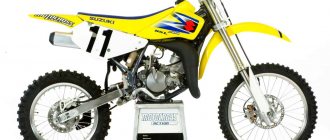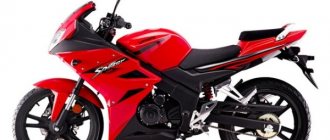| Honda VT250 Spada (1988-1990) |
Honda VT250 Spada naked model
appeared in the Honda line in 1988 and was produced until 1990 inclusive. The motorcycle is a budget model with a V-shaped 2-cylinder engine, an aluminum frame and disc brakes, which was available in the domestic market of Japan and Oceania (particularly Australia).
The model may also have a name - Honda Spada 250
.
The main feature of the Honda VT250 Spada is a 2-cylinder V-shaped (52°) liquid-cooled engine with a volume of 249 cm³ and producing 40 hp. power and 25 Nm of torque. Maximum performance - at 9000-12000 rpm. The engine has 2 camshafts and 4 valves for each cylinder. In addition, the model is equipped with a 6-speed gearbox.
Other features of the Honda VT 250 Spada include an aluminum diagonal frame, simple suspension in the form of a conventional telescopic fork at the front and a progressive monoshock absorber at the rear, disc brakes, an 11-liter fuel tank and 153 kg curb weight.
1990 was the last year of production of the model, after which it disappeared from dealers, and only in 1997 it introduced a new successor - the Honda VTR 250.
The main competitors of the Honda VT 250 Spada in the class:
- Kawasaki Balius 250
- Suzuki GSF 250 Bandit
- Yamaha FZX 250 Zeal
Specifications
Technical characteristics of Honda VT 250 Spada:
| Model | Honda VT250 Spada |
| Motorcycle type | naked |
| Year of issue | 1988-1990 |
| Frame | aluminum diagonal |
| engine's type | 2-cylinder, V-shaped (52°), 4-stroke |
| Working volume | 249 cm³ |
| Bore/Stroke | 60.0 x 44.1 mm |
| Compression ratio | 11.0:1 |
| Cooling | liquid |
| Number of valves per cylinder | DOHC chain drive, 4 valves per cylinder |
| Fuel supply system | Carburetor, x2 Keihin, 34.4 mm |
| Ignition type | CDI |
| Maximum power | 40.0 hp (29.4 kW) at 12,000 rpm |
| Maximum torque | 25.0 Nm (2.6 kg*m) at 9000 rpm |
| Clutch | Multi-disc in oil bath, cable drive |
| Transmission | 6-speed |
| type of drive | chain |
| Front tire size | 100/80-17 (52S) |
| Rear tire size | 140/70-17 (66S) |
| Front brakes | 1 disc, 296 mm, 2-piston caliper |
| Rear brakes | 1 disc, 220 mm, 1-piston caliper |
| Front suspension | Telescopic fork 37 mm |
| Rear suspension | Pendulum with monoshock absorber |
| Motorcycle length | 2010 mm |
| Motorcycle width | 715 mm |
| Motorcycle height | 1020 mm |
| Wheelbase | 1380 mm |
| Seat height | 740 mm |
| Minimum ground clearance (clearance) | 150 mm |
| Acceleration 0-100 km/h (0-60 mph) | 8.0 sec. |
| Maximum speed | 180 km/h |
| Gas tank capacity | 11.0 l (including reserve - 2.0 l) |
| Motorcycle weight (dry) | 140 kg |
| Motorcycle weight (curb) | 153 kg |
Why did it happen so?
Perhaps the automatic requests do not belong to you, but to another user accessing the network from the same IP address as you. You need to enter the characters into the form once, after which we will remember you and be able to distinguish you from other users exiting from this IP. In this case, the page with the captcha will not bother you for quite a long time.
You may have add-ons installed in your browser that can make automatic search requests. In this case, we recommend that you disable them.
It is also possible that your computer is infected with a virus program that is using it to collect information. Maybe you should check your system for viruses.
If you have any problems or would like our support team, please use the feedback form.
Brief review of Honda VT 250 Spada
Honda VT 250 Spada is a small-capacity road motorcycle produced at the turn of the 80s - 90s of the last century and sold exclusively in the Japanese domestic market. However, a number of copies of this model still ride on Russian roads, since the motorcycle has excellent endurance, especially for a modest and inexpensive 250 cc model. During the years of its release it was not very popular, but subsequently it was on the basis of the Honda VT 250 Spada that another model was developed - the Honda VTR 250.
The striking difference between the Honda VT 250 Spada and other small-capacity road cars of the same production years lies in the engine - Japanese designers installed a very powerful V-twin in a technologically advanced diagonal frame. Like all souped-up small-capacity motorcycles, the Spada loves high revs, but at the same time it produces excellent power for 250 cc. see working volume characteristics. At the same time, a powerful engine and a well-designed frame are combined with rather primitive suspensions that are not very suitable for an aggressive driving style.
- Yamaha FZX250 Zeal
- Suzuki GSF250 Bandit
- Kawasaki Balius 250
Reviews
Reviews of Honda VT 250 Spada:
Expand Collapse
This Spada is like a Honda Bros only smaller, the design is actually the same, the engine is from a vtshki, then the best option is xelvis, the most recent one and there is wind protection, the engine life is about 100 thousand, it likes good oil and fresh filters, there is a danger of cranking the liners, so it’s better to go into the red zone Don’t push too hard, but it’s better to drive slowly, check for noise before purchasing)
An excellent bike for beginners, narrow - it fits where scooters stand, lightweight due to its low weight, rides like 400 cc. The engine combines the delights of a V-twin - thrust from idle and revs - for those who like to rev the engine.
Video
- Brief inspection and launch of the Honda VT 250 Spada motorcycle.
Honda VT 250 Spada
- a classic road motorcycle created for the domestic Japanese market, produced, however, only from 1988 to 1991. However, despite the lack of commercial success, this model brought benefit to the company, since, taking into account the experience of its production, another, more popular motorcycle of the same class was subsequently developed - the Honda VTR 250, which is still of interest to many novice motorcyclists, despite the advanced age of all copies. With its entire appearance, the Honda Spada 250 hints at a “sporty” character. Of course, this is still a small motorcycle, but it is really quite good for its class. The 2-cylinder V-shaped liquid-cooled engine is capable of producing very impressive performance - 40 hp. and 25 Nm of torque, turning the Spada into a very nimble device. The light weight of the motorcycle, which is only 150 kg, also plays an important role.
Externally, the Honda Spada uses a classic style with a touch of sportiness. An elongated and flat gas tank at the top, a round headlight, a dashboard located on the steering wheel in chrome “glasses”, an external frame (alloy!), clip-ons - all this is reminiscent of the Suzuki GSF 250 or Kawasaki Balius 250, which, in fact, are the main competitors of VT 250. The modest size of the motorcycle makes it convenient mainly for short motorcyclists. To be fair, it should be noted that this bike is not short on speakers. From the bottom, his Honda Spada 250, of course, drives quite reluctantly, asking for the engine to be revved up properly, but at about 10-11 thousand revolutions the motorcycle transforms, accelerating as quickly as you would not expect from it. The six-speed gearbox, like on other Hondas, works perfectly. the lightweight bike reaches speeds of up to 180 km/h, and the VT250 accelerates from 0 to 100 km/h in about 8 seconds.
VT 250 F
Honda VT250F is a motorcycle made in a sporty style with a small amount of plastic. It was launched by Honda into production in 1982 for the Japanese domestic market and, in a modified form, was removed from the scene in 1997 - still as a domestic Japanese model. Small quantities of the motorcycle were supplied from England and Europe.
The motorcycle is equipped with a two-cylinder DOHC V-shaped engine with a cylinder camber of 90 degrees and 4 valves per cylinder. Compared to in-line twins, the VT250F engine has much less noticeable vibration. In addition, this engine configuration in the VT250F allowed Honda to lower the center of gravity and seat height.
The front brake system consists of a single-disc, two-piston ventilated INBOARD system, where the disc is in the form of a ring secured by the outer diameter, the pads “grab” the disc from the inside and stand “inside” the ring. In those years, Honda used similar systems for some time, after which it switched to today’s more traditional discs, calipers, and pistons.
Suspension VT250F. At the front there are TRAC hydropneumatic fork stays (with the possibility of pumping) without adjustment, and at the rear there is a suspension with a progressive Pro-Link characteristic. WP hydropneumatic monoshock absorber with pumping capability, but without adjustments.
Other features of the Honda VT250F: hydraulic clutch, prefabricated KOMSTAR wheels (later discontinued not because of the backwardness of the design, but because of the complexity and high cost of manufacturing).
The VT250F's riding position is upright, like a classic neoclassic's, but the seat is a bit firm, like the NS250R sportbike. On the left, under the side cover, there is a small luggage compartment where all sorts of small things can fit. To get there you need to remove the seat and unfasten the side cover, then open the box lid. There is also a standard small compartment at the end of the VT250F rear pylon, also closed with a lid.
Following the VT250F, the VT250 Spada and VTR250 models entered the Honda lineup.
Specifications:
Technical data of Honda VT 250F Xelvis (1986):
Power, hp at rpm: 35/11000;
Engine capacity, cm³: 248;
Type of brake front/rear: disc/drum.
Motorcycle Honda VT 250 Spada
VT 250 Spada - This is a classic road bike that has all the hallmarks of the class. The model will be of interest primarily to those who adore everything that has stood the test of time.
The Honda VT 250 Spada is perfect for city streets, but can also be relevant on long country trips.
Bike features
Here are the main features of the machine:
- despite the class, the exterior tends to be sporty;
- impressive engine performance, atypical for the category and era;
- significant acceleration starting from 10,000 rpm.
The bike is ambiguous: on the one hand, it is clearly not suitable for connoisseurs of racing cars, and on the other, its power is too great for a simple road classic. However, this is precisely its distinctive feature, which has proven its worth over the years.
Specifications
The parameters of the Honda VT 250 Spada differ from the average representative of the class. The point is not only in the overly powerful engine, but also in the rigid, essentially sports suspension. However, the brakes, unfortunately, cannot be praised because they are too weak for such a performance bike.
Engine
The motor here has a V-shape. The number of cylinders of this four-stroke unit is two, and its effective volume reaches 249 cm³. The engine exhibits a maximum torque of 25 Nm and a power of 40 hp. In just 8 seconds, this car reaches a speed of 100 km/h, and its top speed is 180 km/h.
Transmission
The drive here is a chain, and the gearbox is six-speed. This car doesn't need anything more. The VT 250 Spada transmission copes with its tasks perfectly, transferring all the power of its zealous engine to the rear wheel.
Dimensions and weight
The length of this motorcycle reaches 2010 mm, its width is 715 mm, and its height is 1020 mm. Seat height – 760 mm. The weight of the model is 150 kg, and its tank volume is 11 liters. On average, the VT 250 Spada consumes from 3.5 to 4 liters of fuel per 100 km of road, but this value can vary significantly if the rider's riding style changes.
Chassis and brakes
Since the bike has some sporting bent, it is not surprising that the frame is bias-ply and aluminum. It looks, however, very classic, and many modern nakeds have a much brighter sporty hint. The steering wheel and rims here are rather inconspicuous.
The suspension at the rear is a progressive monoshock absorber, and at the front is a 37 mm telescopic fork. The VT 250 Spada brakes using a rear disc with a single-piston caliper and a front disc with a two-piston caliper. The braking system is the main drawback of this model, because the single front disc may not be enough.
Production
The VT 250 Spada was produced for a long time - from 1988 to 1991. The model never gained recognition among the target audience, however, thanks to the creation of this motorcycle, a much more successful car from Honda later appeared - the VTR 250. The latter is even today of interest to many beginners.
Classmates
This bike has three rivals. One of them is the FZX 250 Zeal from Yamaha, the other is the GSF 250 Bandit from Suzuki and the third is the Balius 250 from Kawasaki. All of these motorcycles are quite powerful machines that are in some ways superior to the VT 250 Spada. However, in terms of exterior, the latter, perhaps, turned out better.
History of changes
During its short journey, the model did not receive any updates or modifications. If the motorcycle had existed on the assembly line for at least a dozen years, it would probably have had to undergo changes in order to keep up with its contemporaries. Despite its shortcomings, the VT 250 Spada made its modest contribution to the industry.










